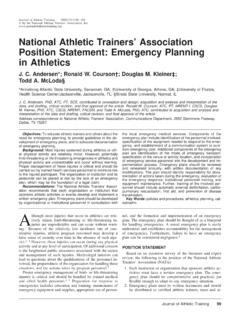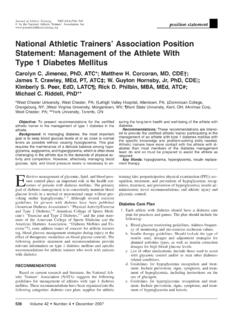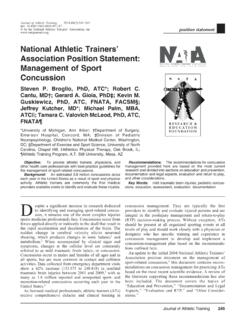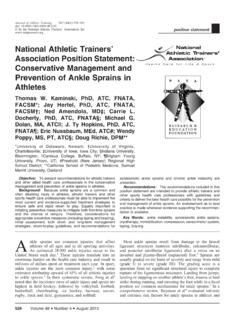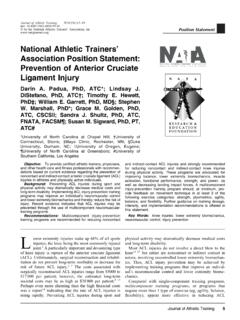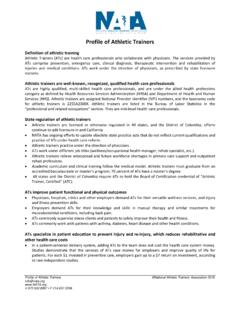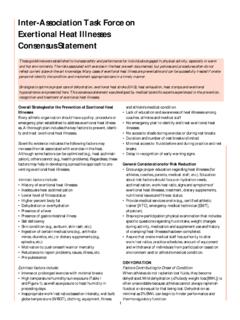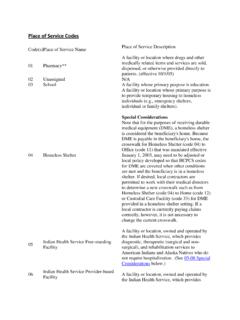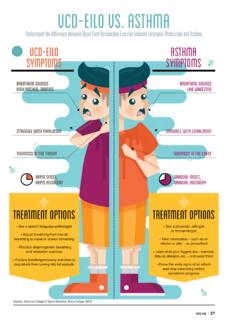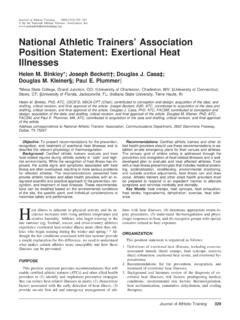Transcription of National Athletic Trainers’ Association Position Statement ...
1 Journal of Athletic Training 2005;40(3):224 245. q by the National Athletic Trainers' Association , Inc National Athletic Trainers' Association Position Statement : Management of Asthma in Athletes Michael G. Miller*; John M. Weiler ; Robert Baker ; James Collins ;. Gilbert D'Alonzo\. *Western Michigan University, Kalamazoo, MI; University of Iowa and CompleWare, Iowa City, IA; Michigan State University Kalamazoo Center for Medical Studies, Kalamazoo, MI; San Diego Chargers, San Diego, CA;. \Temple University School of Medicine, Philadelphia, PA. Michael G. Miller, EdD, ATC, CSCS; John M.
2 Weiler, MD; Robert Baker, MD, PhD, ATC; James Collins, ATC; and Gilbert D'Alonzo, DO, contributed to conception and design; acquisition and analysis and interpretation of the data; and drafting, critical revision, and final approval of the article. Address correspondence to National Athletic Trainers' Association , Communications Department, 2952 Stemmons Freeway, Dallas, TX 75247. Objective: To present guidelines for the recognition, prophy- in supervising therapies to prevent and control asthma symp- laxis, and management of asthma that lead to improvement in toms. It is also important for the Athletic trainer to recognize the quality of care certified Athletic trainers and other heath care when asthma is not the underlying cause for respiratory diffi- providers can offer to athletes with asthma, especially exercise- culties, so that the athlete can be evaluated and treated prop- induced asthma.
3 Erly. Background: Many athletes have difficulty breathing during Recommendations: The recommendations contained in this or after Athletic events and practices. Although a wide variety Position Statement describe a structured approach for the di- of conditions can predispose an athlete to breathing difficulties, agnosis and management of asthma in an exercising popula- tion. Athletic trainers should be educated to recognize asthma the most common cause is undiagnosed or uncontrolled asth- symptoms in order to identify patients who might benefit from ma. At least 15% to 25% of athletes may have signs and symp- better management and should understand the management of toms suggestive of asthma, including exercise-induced asthma.
4 Asthma, especially exercise-induced asthma, to participate as Athletic trainers are in a unique Position to recognize breathing active members of the asthma care team. difficulties caused by undiagnosed or uncontrolled asthma, par- Key Words: airway hyperresponsiveness, airway obstruc- ticularly when asthma follows exercise. Once the diagnosis of tion, exercise-induced asthma, exercise-induced broncho- asthma is made, the Athletic trainer should play a pivotal role spasm, pulmonary function tests, certified Athletic trainer INTRODUCTION ucation and Prevention Program (NAEPP) in March 1989 to A.
5 Sthma is defined as a chronic inflammatory disorder address the increasing prevalence of asthma in the United of the airways characterized by variable airway ob- States and its economic costs to the society; the program was struction and bronchial Airway updated in 1997 (as NAEPPII).1 An updated expert panel re- obstruction can lead to recurrent episodes of wheezing, breath- port from the NAEPP is expected to be released in 2006. The lessness, chest tightness, and coughing, particularly at night or Global Initiative for Asthma (GINA) was also developed to in the early Asthma can be triggered by many stim- provide worldwide guidelines for asthma awareness and man- uli, including allergens (eg, pollen, dust mites, animal dander), These guidelines are extremely comprehensive and pollutants (eg, carbon dioxide, smoke, ozone), respiratory in- have been regularly updated to reflect advances in the diag- fections, aspirin, nonsteroidal anti-inflammatory drugs nosis and management of asthma.
6 Nevertheless, the guidelines (NSAIDs), inhaled irritants (eg, cigarette smoke, household do not describe the role of certified Athletic trainers or other cleaning fumes, chlorine in a swimming pool), particulate ex- allied health care professionals in recognizing and managing posure (eg, ambient air pollutants, ice rink pollution), and ex- asthma in an Athletic population. posure to cold and 5 Airflow limitation is often re- versible, but as asthma symptoms continue, patients may PURPOSE. develop airway remodeling'' that leads to chronic irreversible airway ,7 Severe attacks of asthma can also cause The purpose of this Position Statement is to provide Athletic irreversible airflow obstruction that can lead to ,8 trainers and other allied health care professionals who care for athletes with information to: The National Heart, Lung, and Blood Institute of the Na- tional Institutes of Health launched the National Asthma Ed- 1.
7 Identify the characteristics and diagnostic criteria of asth- 224 Volume 40 Number 3 September 2005. ma, especially exercise-induced asthma (EIA) or exercise- a. Does the patient have breathing attacks consisting of induced bronchospasm (EIB). coughing, wheezing, chest tightness, or shortness of 2. Provide guidelines for referral so that patients with asthma breath (dyspnea)? and those in whom asthma is suspected can receive a thor- b. Does the patient have coughing, wheezing, chest tight- ough evaluation. ness, or shortness of breath (dyspnea) at night? 3. Describe management plans to prevent attacks and to con- c.
8 Does the patient have coughing, wheezing, or chest trol asthma exacerbations when they occur. tightness after exercise? 4. Educate certified Athletic trainers and athletes about phar- d. Does the patient have coughing, wheezing, chest tight- macologic and nonpharmacologic therapies and techniques ness, or shortness of breath (dyspnea) after exposure to to help control asthma. allergens or pollutants? e. Which pharmacologic treatments for asthma or allergic rhinitis, if any, were given in the past, and were they RECOMMENDATIONS successful? Based on current research and literature, the National Ath- 4.
9 Patients with atypical symptoms, symptoms despite proper letic Trainers' Association provides the following guidelines therapy, or other complications that can exacerbate asthma for the identification, examination, management, and prophy- (such as sinusitis, nasal polyps, severe rhinitis, gastro- laxis of asthma, including EIA, and the education of athletes, esophageal reflux disease, or vocal cord dysfunction). parents, coaches, and health care personnel about asthma. Not should be referred to a physician with expertise in sports all individuals who suffer from asthma present in the same medicine (eg, allergist; ear, nose, and throat physician.)
10 Manner, nor do they all respond to the same management or cardiologist; or pulmonologist with training in providing treatment plan. Therefore, these recommendations are intended care for athletes).15 Testing might include a stress electro- to provide the certified Athletic trainer and other health care cardiogram, upper airway laryngoscopy or rhinoscopy, professionals with an overall guide for a better understanding echocardiogram, or upper endoscopy. of the asthmatic condition. Pulmonary Function Testing Asthma Identification and Diagnosis 5. Athletes with a history of asthma or of taking a medica- 1.
